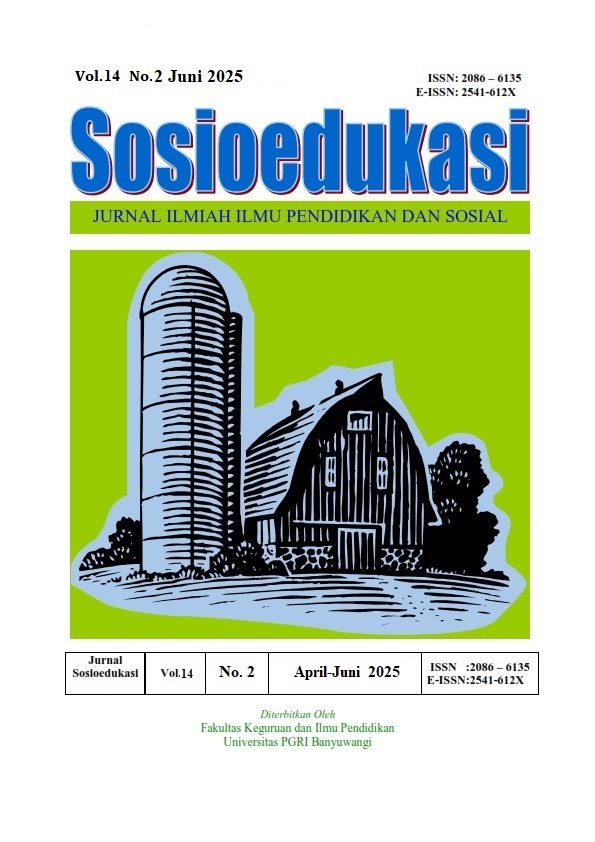NAVIGATING ECONOMIC TURBULENCE: EXCHANGE RATE VOLATILITY AND MACROECONOMIC RESILIENCE IN OPEN ECONOMIES
DOI:
https://doi.org/10.36526/sosioedukasi.v14i1.5771Keywords:
Exchange Rate Volatility, Macroeconomic Resilience, Open Economy, Inflation, Interest Rate, IndonesiaAbstract
Exchange rate volatility significantly impacts developing countries' macroeconomic stability in the global economy. This study investigates the effects of exchange rate fluctuations on key macroeconomic indicators, focusing on Indonesia. Using a qualitative descriptive approach with secondary data from institutional sources and an OLS regression analysis, the research examines the challenges faced by developing nations. Findings reveal that exchange rate volatility substantially influences inflation, economic growth, foreign exchange reserves, and the balance of payments. The Indonesian case study (2013, 2018, and 2022–2023) demonstrates that external factors, particularly global monetary policy changes and geopolitical tensions, primarily drive exchange rate pressures. Short-term policy responses, including adjustments to the BI-7 Day Reverse Repo Rate and foreign exchange market interventions, have proven effective for immediate stability. However, long-term macroeconomic resilience necessitates comprehensive strategies such as economic diversification, institutional strengthening, and sustained policy coordination to mitigate the impacts of exchange rate volatility in developing countries.
References
Aftab, M., Naeem, M., Tahir, M., & Ismail, I. (2024). Does uncertainty promote exchange rate volatility? Global evidence. Studies in Economics and Finance, 41(1), 177–191.
Agosin, M., & Díaz, J. D. (2023). Explaining the volatility of the real exchange rate in emerging markets. International Review of Economics & Finance, 87, 110–123.
Amit, S., & Kafy, A.-A. (2024). Addressing the dollar crisis by investigating underlying causes, effects, and strategic solutions in emerging economies. Research in Globalization, 8, 100187.
Arafat A., L., Meta, W., & Meilisa, M. (2024). Comparison of Vector Autoregressive (VAR) and Vector Error Correction Models (VECM) For the Composite Stock Price Index (JCI) in Indonesia. TRANSEKONOMIKA: AKUNTANSI, BISNIS DAN KEUANGAN, 4(6), 1011–1025. https://doi.org/10.55047/transekonomika.v4i6.754
Arize, A. C. (1998). The effects of exchange rate volatility on US imports: an empirical investigation. International Economic Journal, 12(3), 31–40.
Bahmani‐Oskooee, M., & Hegerty, S. W. (2007). Exchange rate volatility and trade flows: a review article. Journal of Economic Studies, 34(3), 211–255.
Barguellil, A., Ben-Salha, O., & Zmami, M. (2018). Exchange rate volatility and economic growth. Journal of Economic Integration, 33(2), 1302–1336.
Barrot, L.-D., Calderón, C., & Servén, L. (2018). Openness, specialization, and the external vulnerability of developing countries. Journal of Development Economics, 134, 310–328.
Barus, A. C., Firza, S. U., Halim, F., & Ginting, L. T. B. R. (2024). Volatilitas Nilai Tukar Dan Harga Komoditas Global Selama Krisis Laut Merah (Exchange Rate And Global Commodity Price Volatility During Red Sea Crisis). JURNAL AKUNTANSI, KEUANGAN DAN MANAJEMEN (JAKMAN), 5(4), 327–339.
Basu, M. S. S., Boz, M. E., Gopinath, M. G., Roch, M. F., & Unsal, M. F. D. (2020). A conceptual model for the integrated policy framework. International Monetary Fund.
Calvo, G. A. (2006). Monetary policy challenges in emerging markets: Sudden stop, liability dollarization, and lender of last resort. National Bureau of Economic Research Cambridge, Mass., USA.
Canzoneri, M. B., Cumby, R. E., & Diba, B. T. (2001). Fiscal discipline and exchange rate systems. The Economic Journal, 111(474), 667–690.
Carrasco, C. A., & Tovar-García, E. D. (2021). Trade and growth in developing countries: the role of export composition, import composition and export diversification. Economic Change and Restructuring, 54(4), 919–941.
Chen, Z. (2022). The impact of trade and financial expansion on volatility of real exchange rate. Plos One, 17(1), e0262230.
Chugunov, I., Pasichnyi, M., Koroviy, V., Kaneva, T., & Nikitishin, A. (2021). Fiscal and monetary policy of economic development. European Journal of Sustainable Development, 10(1), 42.
Dal Bianco, S., & Loan, N. C. T. (2017). FDI inflows, price and exchange rate volatility: New empirical evidence from Latin America. International Journal of Financial Studies, 5(1), 6.
Devereux, M. B., & Engel, C. (2002). Exchange rate pass-through, exchange rate volatility, and exchange rate disconnect. Journal of Monetary Economics, 49(5), 913–940.
Dominguez, K. M. E. (1993). Does central bank intervention increase the volatility of foreign exchange rates? National Bureau of Economic Research Cambridge, Mass., USA.
Frenkel, J. A., & Razin, A. (1987). The Mundell-Fleming model a quarter century later: a unified exposition. Staff Papers, 34(4), 567–620.
Friedman, B. M., & Kuttner, K. N. (2010). Implementation of monetary policy: How do central banks set interest rates? In Handbook of monetary economics (Vol. 3, pp. 1345–1438). Elsevier.
Gupta, M., & Varshney, S. (2023). Does exchange rate volatility influence import commodities of India-US? Evidence from ARDL approach. South Asian Journal of Business Studies, 12(4), 473–500.
Habib, N., Ariyawardana, A., & Aziz, A. A. (2023). The influence and impact of livelihood capitals on livelihood diversification strategies in developing countries: a systematic literature review. Environmental Science and Pollution Research, 30(27), 69882–69898.
Hau, H. (2002). Real exchange rate volatility and economic openness: theory and evidence. Journal of Money, Credit and Banking, 611–630.
Hutchison, M., Sengupta, R., & Singh, N. (2012). India’s trilemma: Financial liberalisation, exchange rates and monetary policy 1. The World Economy, 35(1), 3–18.
Jolo, A. M., Ari, I., & Koç, M. (2022). Driving factors of economic diversification in resource-rich countries via panel data evidence. Sustainability, 14(5), 2797.
Krušković, B. D. (2022). Central bank intervention in the inflation targeting. Journal of Central Banking Theory and Practice, 11(1), 67–85.
Lee‐Lee, C., & Hui‐Boon, T. (2007). Macroeconomic factors of exchange rate volatility: Evidence from four neighbouring ASEAN economies. Studies in Economics and Finance, 24(4), 266–285.
Löscher, A., & Kaltenbrunner, A. (2023). Climate change and macroeconomic policy space in developing and emerging economies. Journal of Post Keynesian Economics, 46(1), 113–141.
Matschke, J., von Ende-Becker, A., & Sattiraju, S. A. (2023). Capital Flows and Monetary Policy in Emerging Markets around Fed Tightening Cycles. Economic Review (01612387), 108(4).
Morina, F., Hysa, E., Ergün, U., Panait, M., & Voica, M. C. (2020). The effect of exchange rate volatility on economic growth: Case of the CEE countries. Journal of Risk and Financial Management, 13(8), 177.
Naef, A. (2024). Blowing against the Wind? a narrative approach to central Bank foreign exchange intervention. Journal of International Money and Finance, 146, 103129.
Nguyen, V. M. H., Ho, T. H., Nguyen, L. H., & Pham, A. T. H. (2023). The impact of trade openness on economic stability in Asian countries. Sustainability, 15(15), 11736.
Nowak, M. (2004). Can higher reserves help reduce exchange rate volatility?
Olamide, E., Ogujiuba, K., & Maredza, A. (2022). Exchange rate volatility, inflation and economic growth in developing countries: Panel data approach for SADC. Economies, 10(3), 67.
Pretorius, O., Drewes, E., Van Aswegen, M., & Malan, G. (2021). A policy approach towards achieving regional economic resilience in developing countries: Evidence from the SADC. Sustainability, 13(5), 2674.
Rastogi, S., & Kanoujiya, J. (2024). The volatility spillover effect of macroeconomic indicators and strategic commodities on inflation: evidence from India. South Asian Journal of Business Studies, 13(2), 180–200.
Razin, A., & Slemrod, J. (2008). Taxation in the global economy. University of Chicago Press.
Rey, H. (2016). International channels of transmission of monetary policy and the Mundellian trilemma. National Bureau of Economic Research.
Sarno, L., & Taylor, M. P. (2003). The economics of exchange rates. Cambridge university press.
Sheykhi, A., Taleblou, R., & Mohajeri, P. (2025). The impact of exchange rate volatility on economic growth: a meta-analysis approach. Journal of Economic Studies.
Von Hagen, J., Mundschenk, S., Doppelhofer, G., Polleit, T., & Vaubel, R. (2002). Fiscal and monetary policy coordination in EMU. Oesterreichische Nationalbank.
Woodford, M., & Muscatelli, V. (2007). Globalization and monetary control. National Bureau of Economic Research Cambridge, Mass., USA.









.png)

















